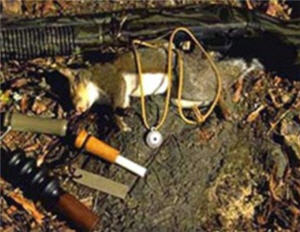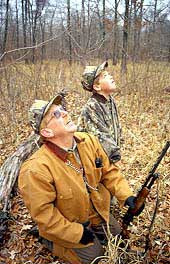
Hunting bushytails during the harsh winter months is tough. Early in the season, squirrels seem to be everywhere. Food supplies are abundant, squirrels are less wary, and leafy branches restrict the game's vision, allowing for closer, easier stalks. The solution for bagging squirrels during this time is simple — find a patch of hardwoods and start hunting.
 |
| Winter hunts are more challenging, but squirrels are still available. |
As the season progresses, however, hunting squirrels becomes increasingly difficult. Hunters have taken a toll on the game, and Mother Nature has claimed the weakest through reduced food supplies, predators and inclement weather. Survivors are savvy veterans that easily elude casual hunters.
Add to this the fact that during severe weather, squirrels may be almost totally inactive and seldom seen. Leaves have fallen, making the hunter more visible to the game he stalks. Nuts no longer cling to the branches, so squirrels are moving more on the ground, making them harder to see at a distance.
Despite all these negatives, however, late-season squirrel hunting can be productive and fun. Winter hunts are more challenging, but squirrels are still available, and the knowledgeable last-minute hunter can enjoy some of the year's best gunning.
Jerry Seamans of Lake Village, Ark., invented the Mr. Squirrel call with hunting partner Shannon Talkington. Seamans, an expert squirrel hunter with decades of experience, is in the woods pursuing his favorite game from early September through February. He notes that his early-season tactics differ greatly from those used during December, January and February.
 |
| Hunters Specialties™ Squirrel Call |
![]() Tip: Find Hunters Specialties Squirrel Call at Cabela's here
Tip: Find Hunters Specialties Squirrel Call at Cabela's here
Winter Squirrel Hunts Require Different Strategies
"There are some major differences in hunting squirrels this time of year,"he says. "One is the fact that the cover in the trees is gone. Leaves have fallen, and that can be both an advantage and a disadvantage. You can see the squirrel easier, but it can see you, too.
"Another thing is, the foods squirrels ate during the early part of the season are mostly on the ground. For that reason, it's a good idea to try finding trees that have held their acorns longer. For example, pin oaks hold their mast a little longer than white oaks. So they're likely to draw lots of squirrels up into their branches where they're easier to spot."
Seamans prefers solitary hunting, usually stalking the woods or watching den trees.
"If you know the location of some den trees, those are good places to hunt this time of year," he says. "Move in as quietly as you can as early as you can, then sit and wait for the squirrels to emerge.
 |
| Squirrel hunting becomes increasingly difficult as the season progresses, as the animals can easily spot and elude casual hunters. |
 "You can also do some still-hunting, moving very slowly and very quietly, trying to spot a squirrel before it spots you,"he adds."I see a lot more squirrels in winter while I'm sitting on a deer stand rather than moving through the woods.The primary reason is, they can see me when I'm moving.If you are moving, be sure you're wearing good camouflage.I believe in wearing camo hunting clothing regardless of when you're hunting, but it's especially important when the leaves are off.Some hunters think you can get away with a little less camo when squirrel hunting, but squirrels have good eyes just like deer, ducks and other wild animals."
"You can also do some still-hunting, moving very slowly and very quietly, trying to spot a squirrel before it spots you,"he adds."I see a lot more squirrels in winter while I'm sitting on a deer stand rather than moving through the woods.The primary reason is, they can see me when I'm moving.If you are moving, be sure you're wearing good camouflage.I believe in wearing camo hunting clothing regardless of when you're hunting, but it's especially important when the leaves are off.Some hunters think you can get away with a little less camo when squirrel hunting, but squirrels have good eyes just like deer, ducks and other wild animals."
Joe Huggins of Benton, Ark., is Hunter Education Coordinator for the state Game & Fish Commission. He, too, is an expert hunter, having pursued these bushy-tailed nutshuckers in sweet pecan woods along the lower Arkansas River since childhood. Trees in these bottoms frequently exceed 100 feet in height. A motionless squirrel can be hard to spot.
"That's why I prefer hunting in December and January,"Huggins says. "Mast has fallen by then, so squirrels do most of their foraging on the ground where they"re easier for me to spot. It's cold at night, too, sometimes down in the 20s or teens. That means squirrels come out of their nests and dens a little later that time of year. You don't have to be out there at the crack of dawn to hunt them. They'll wait till it warms a little, around 9 a.m. or so, before they're out feeding, and you'll see most of them scratching through leaves on the ground."
Unlike Seamans who usually hunts solo, Huggins prefers to hunt with a partner in winter.
![]() Tip: How to Skin Squirrels: Step by Step Guide
Tip: How to Skin Squirrels: Step by Step Guide
 "As we're stalking through the woods, we'll scare up a lot of squirrels on the ground," he says. "Usually, they'll jump on the side of a tree then hit the ground running. Watch them, and chances are you'll see them run into a den tree or a tree that's covered with vines. You're pretty much out of luck if they make it to a den hole. But if they scamper up a tree that has some vines going up it, two hunters can bag them nearly every time."
"As we're stalking through the woods, we'll scare up a lot of squirrels on the ground," he says. "Usually, they'll jump on the side of a tree then hit the ground running. Watch them, and chances are you'll see them run into a den tree or a tree that's covered with vines. You're pretty much out of luck if they make it to a den hole. But if they scamper up a tree that has some vines going up it, two hunters can bag them nearly every time."
One hunter lays his shotgun down and grabs a vine. The other backs off where he has a good view of the tree's crown and trunk and prepares for action.
"The squirrel knows you're there, so he's going to be clinging to the bark, moving around the tree to stay out of sight," Huggins says. "Sometimes he'll be laying on top of a limb or in a fork. When you shake the vine, he's not likely to take off running. But he is likely to dart around the side of the tree or branch. The guy with the gun watches closely for movement, circling the tree if necessary. When he sees the squirrel, he tells his partner, makes sure he has a safe shot, then tries to make a kill."
As the worst days of winter take hold toward the end of January, squirrels are more likely to feed then go up on a high limb and lay, soaking up the sun to stay warm. "They're like totally different animals then," says Huggins. "And because they're harder to spot, they're harder to hunt, too. If you have a choice, hunt before the really frigid weather sets in."
Bag More Squirrels With These Hunting Tricks
Like Seamans and Huggins, I also enjoy the challenge of late-season squirrel hunting. With 30 years of experience under my belt, I've learned some tricks that help me bag several dozen squirrels each winter. Here are a few:
- In country with a mix of small woodlots and big woods, work smaller patches during the late season. Small tracts often are overlooked by other hunters, and though they may not hold large numbers of squirrels, the restricted environment makes bushytails easier to find.
- Don't stalk and hunt at the same time. Concentrate on moving noiselessly with your eyes to the ground, pausing frequently to study your surroundings for game. Search the woods a couple hundred yards ahead. If you don't, squirrels will see you and be hidden before you're aware of them.
- When you spot a squirrel, move in waltz time. The slower you go, the better.
- If you have a choice between hunting a ridge and a creek bottom, stick to the creek bottom. The leaves will be wetter and the going quieter. You'll also be keeping a lower profile so squirrels won't be as likely to spot you.
- If possible, hunt mountains or hilly areas when wind conditions are unfavorable. Scouting often reveals hollows where calmer conditions prevail and squirrels are more active.
- If what you've been doing so far hasn't produced the desired results, give these tips a try. Ol' Bushytail's brain may not be any bigger than a hickory nut, but he's got plenty of smarts tucked away inside. To outwit him, you have to be better at playing his games than he is.
- 51281 views

